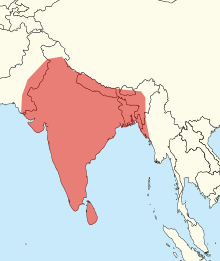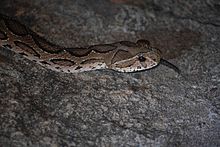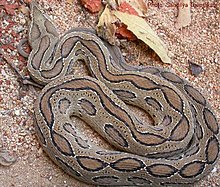Russell's viper
| Russell's viper | |
|---|---|

| |
| Scientific classification | |
| Domain: | Eukaryota |
| Kingdom: | Animalia |
| Phylum: | Chordata |
| Class: | Reptilia |
| Order: | Squamata |
| Suborder: | Serpentes |
| Family: | Viperidae |
| Genus: | Daboia |
| Species: | D. russelii
|
| Binomial name | |
| Daboia russelii | |

| |
| Daboia russelii distribution | |
| Synonyms | |
| |

Russell's viper (Daboia russelii) is a
Taxonomy
English naturalist George Shaw—with illustrator Frederick Polydore Nodder—in The Naturalist's Miscellany: Or, Coloured Figures Of Natural Objects; Drawn and Described Immediately From Nature formally described the species in 1797 as Coluber russelii, from a specimen presented to the British Museum by Scottish herpetologist Patrick Russell.[1] Russell had written of the species in his 1796 work An account of Indian serpents, collected on the coast of Coromandel, confirming its highly venomous nature by experimenting on chickens and dogs. He added the native people called it katuka retula poda.[2]
Analysis of morphological and mitochondrial DNA data shows that the eastern subspecies of D. russelii should be considered a separate species, Daboia siamensis.[3]
A number of other subspecies may be encountered in literature,[4] including:
- D. s. formosensis (Maki, 1931) – found in Thailand (considered a synonym of D. siamensis).
- D. s. limitis (Mertens, 1927) – found in Indonesia (considered a synonym of D. siamensis).
- D. r. pulchella (Gray, 1842) – found in Sri Lanka (considered a synonym of D. russelii).
- D. r. nordicus (Deraniyagala, 1945) – found in northern India (considered a synonym of D. russelii).
The correct spelling of the species, D. russelii, has been, and still is, a matter of debate. Shaw and Nodder (1797), in their account of the species Coluber russelii, named it after Patrick Russell, but apparently misspelled his name, using only one "L" instead of two. Russell (1727–1805) was the author of An Account of Indian Serpents (1796) and A Continuation of an Account of Indian Serpents (1801). McDiarmid et al. (1999) are among those who favor the original misspelling, citing Article 32c (ii) of the International Code of Zoological Nomenclature. Others, such as Zhao and Adler (1993) favor russellii.[5]
Etymology
The species is named after
In English, common names of D. russelii include Russell's viper,[4][8][9][10] chain viper,[8][10] Indian Russell's viper,[11][12] common Russell's viper,[13] seven pacer,[14] chain snake, and scissors snake.[15]
Description



The head is flattened, triangular, and distinct from the neck. The snout is blunt, rounded, and raised. The nostrils are large, each in the middle of a large, single
The crown of the head is covered with irregular, strongly fragmented scales. The
The body is stout, the cross-section of which is rounded to circular. The
Russell's viper grows to a maximum body and tail length of 166 cm (65 in) and averages about 120 cm (47 in) in mainland Asia. On islands, it is slightly shorter on average.[4] It is more slender than most vipers.[17] The following dimensions for a "fair-sized adult specimen" were reported in 1937:[18]
- Total length 1.24 m (4 ft 1 in)
- Length of tail 430 mm (17 in)
- Girth 150 mm (6 in)
- Width of head 51 mm (2 in)
- Length of head 51 mm (2 in)
Distribution and habitat
Russell's viper is found in India, Sri Lanka, Bangladesh, Nepal, and Pakistan. Populations from South-East Asia previously assigned to this species are now considered to be part of a different species,
Within its range, it can be common in some areas, but scarce in others..
Russell's viper is not restricted to any particular habitat, but does tend to avoid dense forests. The snake is mostly found in open, grassy or bushy areas, but may also be found in
This species is often found in highly urbanized areas and settlements in the countryside, the attraction being the rodents commensal with man.[16] As a result, those working outside in these areas are most at risk of being bitten. D. russelii does not associate as closely with human habitation as Naja and Bungarus species (cobras and kraits).[4]
Behaviour and ecology
Russell's viper is
Although this genus does not have the heat-sensitive pit organs common to the
Reproduction
Russell's viper is ovoviviparous.[17] Mating generally occurs early in the year, although pregnant females may be found at any time. The gestation period is more than six months. Young are produced from May to November, but mostly in June and July. It is a prolific breeder. Litters of 20–40 are common,[4] although fewer offspring may occur, as few as one.[16] The reported maximum is 75[23] in a single litter. At birth, juveniles are 215–260 mm (8.5–10.2 in) in total length. The minimum total length for a gravid female is about 100 cm (39 in). It seems that sexual maturity is achieved in 2–3 years. In one case, it took a specimen nearly 4.5 hours to give birth to 11 young.[4]
Prey

Russell's viper feeds primarily on rodents, although it will also eat small reptiles,
Mimicry

Some
Venom
Venom of this species is delivered by means of
The LD50 in mice, which is used as a possible indicator of snake venom toxicity, is: 0.133 mg/kg intravenous,[25] 0.40 mg/kg intraperitoneal,[26] about 0.75 mg/kg subcutaneous.[27] For most humans, a lethal dose is about 40–70 mg, well within the amount that can be delivered in one bite. In general, the toxicity depends on a combination of five different venom fractions, each of which is less toxic when tested separately. Venom toxicity and bite symptoms in humans vary within different populations and over time.[4] In another study, Meier and Theakston reported that the lethality of venom of Russell viper varies with change in route of injection, as their results predicts the LD50 of 0.4 mg/kg through intraperitoneal (I.P) route, 0.75 mg/kg/subcutaneous (S.C) route and 0.3 mg/kg through intravenous (I.V) route.[28]
Symptoms
Envenomation symptoms begin with pain at the site of the bite, immediately followed by swelling of the affected extremity. Bleeding is a common symptom, especially from the gums and in the urine, and
Severe pain may last for 2–4 weeks. It may persist locally, depending on the level of tissue damage. Often, local swelling peaks within 48–72 hours, involving both the affected limb and the trunk. If swelling up to the trunk occurs within 1–2 hours, envenomation is likely to be massive. Discoloration may occur throughout the swollen area as red blood cells and plasma leak into muscle tissue.
A study in The Lancet showed that out of a sample of people who survived bites by D. russelii, 29% suffered severe damage to their pituitary glands, which later caused hypopituitarism.[29] Other scientific studies support the hypothesis that D. russelii bites can cause hypopituitarism.[30][31]
Antivenom treatment
In India, the Haffkine Institute prepares a polyvalent antivenom that is used to treat bites from this species.[16] In late 2016, a new antivenom had been developed by the Costa Rican Clodomiro Picado Institute, and clinical trials were started in Sri Lanka.[32]
Clinical use
Because this venom is so effective at inducing
References
- ^ Shaw, George (1797). "The Russelian Snake". The Naturalist's Miscellany. 8: 291–293.
- ^ Russell, Patrick (1796). An account of Indian serpents, collected on the coast of Coromandel. Vol. 1. London: W. Bulmer and Co. Shakespeare-Press. p. 10. Archived from the original on 2023-02-10. Retrieved 2020-08-15.
- ^ a b Thorpe RS, Pook CE, Malhotra A (2007). "Phylogeography of the Russell's viper (Daboia russelii) complex in relation to variation in the colour pattern and symptoms of envenoming". Herpetological Journal. 17: 209–18.
- ^ ISBN 0-89464-877-2.
- ^ ISBN 1-893777-01-4(volume).
- ISBN 978-1-4214-0135-5. (Daboia russelii, pp. 229-230).
- ISBN 0-19-861258-3.
- ^ a b Snakes of Thailand: Venomous snakes Archived 2016-03-30 at the Wayback Machine at Siam-Info Archived 2016-05-06 at the Wayback Machine. Retrieved 20 October 2006.
- ^ Daboia russelii at the Reptarium.cz Reptile Database. Accessed 2 August 2007.
- ^ a b . Retrieved 20 October 2006.
- ^ Captive Care of the Russell's viper Archived 2008-04-09 at the Wayback Machine at VenomousReptiles.org. Retrieved 14 March 2007. Archived April 9, 2008, at the Wayback Machine
- ^ Somaweera A (2007). Checklist of the Snakes of Sri Lanka. Peradeniya, Sri Lanka: Department of Zoology, Faculty of Science, University of Peradeniya. PDF Archived 2008-09-20 at the Wayback Machine at Sri Lanka Reptile Archived 2009-08-18 at the Wayback Machine. Retrieved 14 March 2007.
- ISBN 0-8069-6460-X.
- ISBN 0-398-02808-7.
- ^ ISBN 0-486-26629-X.
- ^ ISBN 0-19-566099-4.
- ^ ISBN 0-448-11856-4.
- ^ a b Ditmars, R.L. (1937). Reptiles of the World: The Crocodilians, Lizards, Snakes, Turtles and Tortoises of the Eastern and Western Hemispheres. New York: The MacMillan Company.
- ^ Whitaker Z (1989). Snakeman: The Story of a Naturalist. Bombay: India Magazine Books. 184 pp. ASIN B0007BR65Y.
- from the original on 2023-02-10. Retrieved 2009-11-29.
- from the original on 2023-02-10. Retrieved 2008-02-22.
- PMID 9624452.
- ^ "Russell's Viper delivers 75 snakelets". Bangalore Mirror. Archived from the original on 2020-07-11. Retrieved 2020-07-11.
- ^ Mao, Shou-Hsian (May 19, 1967). "Bite Patterns of Taiwan Venomous and Non-Venomous Snakes" (PDF). zoolstud.sinica.edu.tw. Archived (PDF) from the original on December 23, 2021. Retrieved December 23, 2021.
- ^ "LD50 - intravenous". Archived from the original on 2011-07-16. Retrieved 2012-01-08.
- ^ "LD50 - intraperitoneal". Archived from the original on 2009-07-18. Retrieved 2012-01-08.
- ^ "LD50 - subcutaneous". Archived from the original on 2005-02-05. Retrieved 2012-01-08.
- PMID 3715904.
- ^ "The deadly Russell Viper: How the snake's venom affects humans". May 4, 2015. Archived from the original on December 13, 2020. Retrieved November 29, 2020.
- S2CID 41839362.
- PMID 21115460.
- ^ Rodrigo, Malaka (9 October 2016). "Trials to start for home-grown anti-venom". The Sunday Times (Sri Lanka). Archived from the original on 20 July 2021. Retrieved 20 July 2021.
- ^ Antiphospholipid Syndrome Archived 2006-11-17 at the Wayback Machine at SpecialtyLaboratories Archived 2019-04-02 at the Wayback Machine. Retrieved 27 September 2006.
Further reading
- Hawgood BJ (November 1994). "The life and viper of Dr Patrick Russell MD FRS (1727–1805): physician and naturalist". Toxicon. 32 (11): 1295–304. PMID 7886689.
- Adler K, Smith HM, Prince SH, David P, Chiszar D (2000). "Russell's viper: Daboia russelii not Daboia russellii, due to Classical Latin rules". Hamadryad. 25 (2): 83–5.
- Boulenger GA (1890). The Fauna of British India, Including Ceylon and Burma. Reptilia and Batrachia. London: Secretary of State for India in Council. (Taylor and Francis, printers). xviii + 541 pp. ("Vipera russellii", pp. 420–421, Figure 123).
- Boulenger GA (1896). Catalogue of the Snakes in the British Museum (Natural History). Volume III., Containing the...Viperidæ. London: Trustees of the British Museum (Natural History). (Taylor and Francis, printers). xiv + 727 pp. + Plates I.- XXV. ("Vipera russellii", pp. 490–491).
- Breidenbach CH (1990). "Thermal cues influence strikes in pitless vipers". Journal of Herpetology. 24 (4). Society for the Study of Reptiles and Amphibians: 448–50. JSTOR 1565074.
- Cox M (1991). The Snakes of Thailand and Their Husbandry. Malabar, Florida: Krieger Publishing Company. 526 pp. ISBN 0-89464-437-8.
- Daniels JC (2002). Book of Indian Reptiles and Amphibians Mumbai: Bombay Natural History Society/Oxford University Press. viii + 238pp.
- ISBN 0-88359-056-5. (Russell's viper, "Daboia russelii", p. 60).
- Dimitrov GD, Kankonkar RC (February 1968). "Fractionation of Vipera russelli venom by gel filtration. I. Venom composition and relative fraction function". Toxicon. 5 (3): 213–21. PMID 5640304.
- Dowling HG (1993). "The name of Russell's viper". Amphibia-Reptilia. 14 (3): 320. .
- Gharpurey K (1962). Snakes of India and Pakistan. Bombay, India: Popular Prakishan. 79 pp.
- Groombridge B (1980). A phyletic analysis of viperine snakes. Ph-D thesis. City of London: Polytechnic College. 250 pp.
- Groombridge B (1986). "Phyletic relationships among viperine snakes". In: Proceedings of the third European herpetological meeting; 1985 July 5–11; Charles University, Prague. pp 11–17.
- Jena I, Sarangi A (1993). Snakes of Medical Importance and Snake-bite Treatment. New Delhi: SB Nangia, Ashish Publishing House. 293 pp.
- Lenk P, Kalyabina S, Wink M, PMID 11286494.
- Mahendra BC (1984). "Handbook of the snakes of India, Ceylon, Burma, Bangladesh and Pakistan". Annals of Zoology (Agra, India) 22.
- Master RW, Rao SS (July 1961). "Identification of enzymes and toxins in venoms of Indian cobra and Russell's viper after starch gel electrophoresis". J. Biol. Chem. 236 (7): 1986–90. PMID 13767976.
- Minton SA Jr. (1974). Venom Diseases. Springfield, Illinois: CC Thomas Publishing. 386 pp.
- Morris PA (1948). Boy's Book of Snakes: How to Recognize and Understand Them. A volume of the Humanizing Science Series, edited by Jacques Cattell. New York: Ronald Press. viii + 185 pp. (Russell's viper, "Vipera russellii", pp. 156–157, 182).
- Naulleau G, van den Brule B (1980). "Captive reproduction of Vipera russelli". Herpetological Review. 11. Society for the Study of Amphibians and Reptiles: 110–2.
- Obst FJ (1983). "Zur Kenntnis der Schlangengattung Vipera". Zoologische Abhandlungen. 38. Staatliches Museums für Tierkunde in Dresden: 229–35. (in German).
- Reid HA (1968). "Symptomatology, pathology, and treatment of land snake bite in India and southeast Asia". In: Bucherl W, Buckley E, Deulofeu V (editors). Venomous Animals and Their Venoms. Vol. 1. New York: Academic Press. pp 611–42.
- Shaw G, Nodder FP (1797). The Naturalist's Miscellany. Volume 9. London: Nodder and Co. 65 pp. (Coluber russelii, new species, Plate 291).
- Shortt (1863). "A short account of the viper Daboia elegans (Vipera Russellii)". Annals and Magazine of Natural History. 11 (3): 384–5.
- Silva A de (1990). Colour Guide to the Snakes of Sri Lanka. Avon (Eng): R & A Books. ISBN 1-872688-00-4. 130 pp.
- Sitprija V, Benyajati C, Boonpucknavig V (1974). "Further observations of renal insufficiency in snakebite". Nephron. 13 (5): 396–403. PMID 4610437.
- Smith MA (1943). The Fauna of British India, Ceylon and Burma, Including the Whole of the Indo-Chinese Sub-region. Reptilia and Amphibia. Vol. III.—Serpentes. London: Secretary of State for India. (Taylor and Francis, printers). xii + 583 pp. ("Vipera russelli", pp. 482–485).
- Thiagarajan P, Pengo V, Shapiro SS (October 1986). "The use of the dilute Russell viper venom time for the diagnosis of lupus anticoagulants". Blood. 68 (4): 869–74. PMID 3092888.
- Maung-Maung-Thwin, Khin-Mee-Mee, Mi-Mi-Kyin, Thein-Than (1988). "Kinetics of envenomation with Russell's viper (Vipera russelli) venom and of antivenom use in mice". Toxicon. 26 (4): 373–8. PMID 3406948.)
{{cite journal}}: CS1 maint: multiple names: authors list (link - Mg-Mg-Thwin, Thein-Than, U Hla-Pe (1985). "Relationship of administered dose to blood venom levels in mice following experimental envenomation by Russell's viper (Vipera russelli) venom". Toxicon. 23 (1): 43–52. PMID 3922088.)
{{cite journal}}: CS1 maint: multiple names: authors list (link - Tweedie MWF (1983). The Snakes of Malaya. Singapore: Singapore National Printers Ltd. 105 pp. ASIN B0007B41IO.
- Vit Z (1977). "The Russell's viper". Prezgl. Zool. 21: 185–8.
- Wall F (1906). "The breeding of Russell's viper". Journal of the Bombay Natural History Society. 16: 292–312.
- Wall F (1921). Ophidia Taprobanica or the Snakes of Ceylon. Colombo, Ceylon [Sri Lanka]: Colombo Museum. (H.R. Cootle, Government Printer). xxii + 581 pp. ("Vipera russelli", pp. 504–529, Figures 91-92).
- Whitaker R (1978). Common Indian Snakes. New Delhi (India): MacMillan. 85 pp.
- Wüster W (1992). "Cobras and other herps in south-east Asia". British Herpetological Society Bulletin. 39: 19–24.
- Wüster W, Otsuka S, Malhotra A, Thorpe RS (1992). "Population Systematics of Russell's viper: A Multivariate Study". Biological Journal of the Linnean Society. 47 (1): 97–113. .
- ISBN 0-916984-28-1.
External links
- Daboia russelii at the Reptarium.cz Reptile Database. Accessed 5 September 2007.
- Russell's viper at Michigan Engineering. Accessed 5 September 2007.
- Russell's viper at SurvivalIQ. Accessed 5 September 2007.
- Mark O'Shea in Sri Lanka at Mark O'Shea. Accessed 5 September 2007.
- Common Poisonous Snakes in Taiwan at Formosan Fat Tire. Accessed 5 September 2007.
- Video of Daboia russelii on YouTube. Accessed 5 September 2007.
- Video of Daboia russelii feeding on YouTube. Accessed 5 September 2007.
- Toxicology


